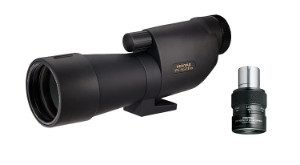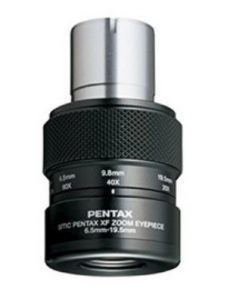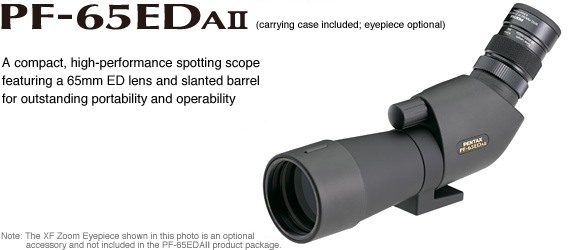
Viewing Configuration: Straight
Magnification: 20-60X
Power Variability: Variable
Adjustable Eyepieces: Yes
Eyepiece included: Yes
Objective Diameter: 65 mm
Close Focus Distance: 16.4 ft
Length: 10.6 in (objective module only)
Weight: 37.7 oz (objective module only)
Field of View: 111-51 ft/1000 yards
Eye Relief/Exit Pupil: 15-11 mm/3.2-1.1 mm
Optics Coatings: Fully multi-coated
Glass: Unknown
Focus System: Center/Single
Waterproof/Fog-proof: Yes
Digiscope adaptable: Yes
Best Uses: Hunting, Target Shooting, Bird Watching, Wildlife Observation, Astronomical Use
Pentax PF-65ED II Spotting Scope Review
Pentax is a well-known brand for quality and innovation. You might be more familiar with the well-deserved ravings of the recently discontinued PF-100ED spotting scope that can spot bullet groupings on white at 1,000 yards.
This is the honest truth, but granted, the atmospheric conditions were practically perfect. Moving away from that, we expect a lot from the PF-65ED. It might be a different scope, but all the same quality is there.

The most obvious feature about the PF spotters is the interchangeable eyepiece system. This is something that buyers absolutely adore since they can change out eyepieces for the appropriate type of activity.
The PF spotters are typically compatible with various types of eyepieces making them an ideal purchase for those who are attracted to this feature.
As expected, this particular model comes with the 20-60x eyepiece included in the purchase. You do have to be extra cautious about the purchasing process as the objective module is also sold without the eyepiece. One giveaway may be the low price as the included eyepiece will always cause a price jump.
The other noticeable feature is the objective lens that contains the ED glass elements for eliminating chromatic aberration. It's often said by users that color fidelity, resolution, and brightness is always true even to max power on a Pentax. If you're a photographer, this feature will make all the difference in quality shots.
Additional features include a sight line on the objective lens hood, built-in, retractable sunshade, and an easy-to-access focus knob that can be conveniently reached by either hand.
Both models of the PF-65 spotter (with the eyepiece and without) are highly-rated. It's the interchangeable eyepiece system, light weight, and excellent image quality that sells it over and over again.
Pros:
- Price
- Interchangeable eyepieces
- Lightweight
- ED glass elements
- Weatherproof/fogproof
- Single focus
Cons:
- Eyepiece/objective module buying confusion
Pentax PF-65ED II & PF-65EDA II Q&A:
Does this PF 65 ED II spotting scope come with the eyepiece included?
This particular model that we are featuring does include the 20-60x eyepiece. We chose this model because it's highly likely that a buyer would want an included eyepiece in the purchase. However, there are multiple smc PENTAX XF-series eyepieces that have been exclusively designed for the 65 ED II spotting scopes. To purchase just the PF-65ED II objective module is extremely cheap compared to competitive scopes in the market, but you will have to purchase an eyepiece separately.
What are the XF-Series eyepieces available from Pentax?
Pentax-specific eyepieces offers a range of both zoom and fixed magnification ocular models. Within the XF-Series, you have the smc PENTAX XF 8.5 with 46x magnification, smc PENTAX XF12 with 32.5x magnification, and this smc PENTAX XF Zoom Eyepiece 6.5mm-19.5mm eyepiece with 20-60x magnification.
Additional compatible eyepieces are the smc PENTAX XW7 55.5x, smc PENTAX XW10 39x, smc PENTAX XW14 28x, smc PENTAX XW20 19.5x, and the smc PENTAX 8-24mm 16-18x models.
What is the Pentax PF-65EDA II Spotting Scope?
The "A" indicates the angled model of the Pentax spotting scope.
What are the differences between the PF-65ED II & the PF-65EDA II?
There are a couple differences between the two models. Although they sport the exact same optical and dimension specs, the angled model has a click-stop rotating feature allowing it to be twisted on an angle for the most convenient viewing.
The carrying case is also specified to be compatible for use on the straight model while using it. Pentax doesn't specify this feature with the angled model, but it's been done with a little difficulty in removing the hood from the front of the lens. Once that's been achieved, it doesn't pose any interfering issues during use on the angled model.
Does the PF-65EDA II come with an eyepiece?
Just like its straight sibling, it's available with an included eyepiece and without. The included eyepiece will be the 20-60x model. Just be sure to confirm or to carefully read the description before assuming an eyepiece is included.

Does the Pentax PF 65 ED II Spotting Scope have Dual Focus?
Unfortunately, the focus knob is a single focus mechanism. However, this isn't necessarily a bad thing. We do like to see dual focus on a long range spotting scope with the quality this one sports but Pentax shows how well a single focus can function versus two sloppy controls. Pentax keeps quality where it needs to be and where they can provide it well.
Where is the 65 ED II Pentax Spotting Scope Made?
This Pentax scope and the PF80 series are all made in Japan.
Noteworthy Features:
- Extra-low dispersion glass elements to reduce CA
- Excellent image quality across entire field of view
- Lightweight and compact for convenience and portability
- Interchangeable eyepieces available; works with multiple Pentax eyepieces
- Fully weatherproof and fogproof with durable, shock-proof rubber armor
Our Verdict on the PF-65ED II Spotting Scope
The scoop on the scope is, the Pentax PF-65ED II spotting scope is one of the best investments you'll ever make. It's definitely not a cheap buy, but it's absolutely more affordable than other brands with the same quality.
When shopping for a Pentax, just be sure to double-check if you want an included eyepiece or not.

If you want bigger, you can always get it. The Pentax PF-80EDA spotter is often a contender against other 80 mm scopes because it has every right to be. When it comes to price, handling, and eyepiece quality, the PF-80 has it!
The Vortex Diamondback spotting scope still tops the charts for affordable spotters. If there's a comparable scope in the same price range as the Pentax, it's going to be a spotting scope from Vortex!
Pentax has a world-class reputation when it comes to their eyepieces. Put a completely waterproof eyepiece onto their well-balanced, shock-proof, and lightweight objective module, and you have a recipe for long range success at your disposal!
Further Reading
- Maven S.3A 20-40X67 Spotting Scope Review – Hands-On Field Test!
- Maven CS.1 Review - 15-45x65 Spotting Scope (Real Hands On Field Test)
- Leupold SX2 Alpine HD Spotting Scope Review (Angled)
- Maven S.1A 25-50 X 80mm Spotting Scope Review (Angled Body)
- Zeiss Victory Harpia Spotting Scope Review - 85mm Angled with Dual Speed Focus System




I love the scope. I have it in the straight version with the XW14. I put it on a Gitzo monopod and it is a magical combo because it is super light and easy to carry around and deploy. Car door use is great. The mono slips down the side of the seat near the window and it is great. The 80 would be too big for this. I have the 80 in angled but have decided I will sell it because I like the other two scopes so much more. And I like the straight for ease of finding the subject.
The 65 is with me more than any other scope because it is light and easy. I have the PF100 that I use on a large tripod for stars or for long distance viewing. Traveling with the rig is harder so it stays with me in the fort.
It is 28x magnification and that is plenty for most uses.
Thanks for the feedback on your experience with the different sized Pentax scopes Tom!